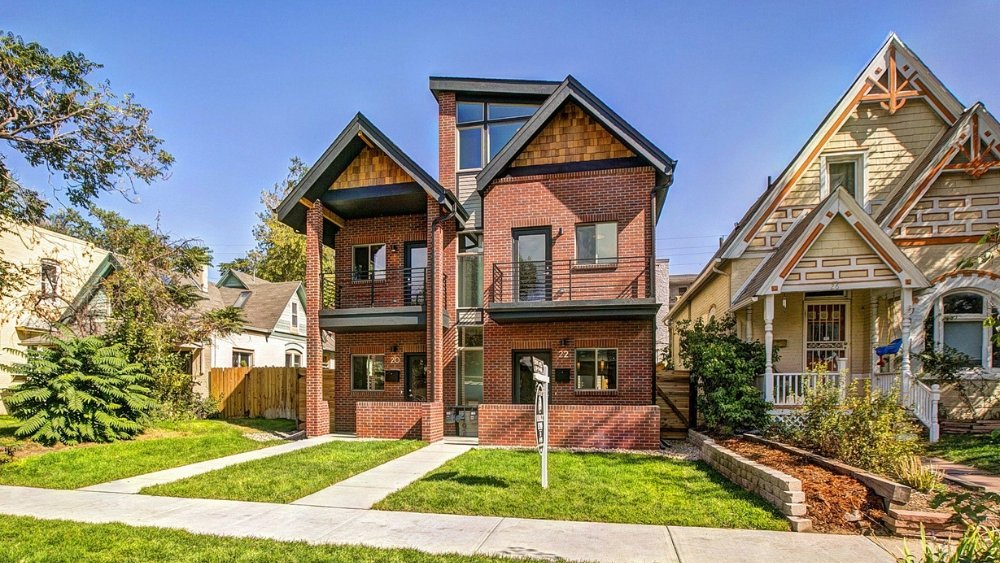North Carolina Hopes Small Code Change Fills Big Housing Needs
(Source: Flickr/Sightline Institute.)
Restrictive local zoning and minimum parking requirements are well-documented impediments to building more missing-middle housing. A lesser-known, but equally influential, factor is the International Building Code (IBC), under which four-unit residential construction faces many of the same expensive safety requirements as much larger commercial facilities.
Aaron Lubeck, a North Carolina-based developer, frames this problem starkly: “The exact same codebook in America governs a triplex and an airport.”
The state of North Carolina has taken legislative action to address the issue. Under a new provision in HB488, any dwelling with three or four housing units would be subject to the less-restrictive International Residential Code (IRC), as 1–2 unit buildings currently are. By eliminating expensive requirements such as mandatory sprinkler systems and fire-rated doors, housing projects should pencil out at lower costs, which incremental housing advocates say could be a boost to small-scale development in communities that desperately need more housing inventory.
The specific language, which takes effect at the beginning of 2025, would “amend the North Carolina Residential Code to include three-family (triplex) and four-family (quadplex) dwellings within its scope by modifying, transitioning, and establishing minimum prescriptive requirements to address the design and construction of those dwellings and make conforming changes to the Code in accordance with this section.”
Learn more about our incremental housing campaign.
North Carolina State Representative Mark Brody, who co-sponsored the bill, says the state is struggling with its own success. Recent economic development projects have brought dozens of new businesses and thousands of new residents to North Carolina. But there’s been no concerted effort to add the additional housing to account for them. He says his goal in championing this provision is “to take (construction) out of commercial and get into residential. Because then it's just a normal house.”
Brody ties these efforts to a historically popular housing type that he and his family benefited from. He grew up in Milwaukee in a duplex with his grandparents living upstairs, and was able to afford his first house by having tenants in upstairs apartments. He hopes to enable small-scale projects with local landlords as a way to add housing and reinvigorate neighborhoods.
Lubeck frames the challenges facing North Carolina as part of a broader regional pattern. He describes the American South as “the last region of the developed world to urbanize,” and, as a result, “we're building these cities under a set of rules that neither New York, Chicago, or San Francisco had.” He describes the 20th-century rules as “radically suburban and difficult to work with in every single way,” and writes about these challenges on Southern Urbanism.
Eric Kronberg, a Georgia-based developer, welcomes the change but says many impediments still remain for incremental housing, and the economics of building an individual fourplex are challenging. But the revisions will have some immediate benefits, including lower labor costs for residential contractors and subcontractors compared to “commercial guys that need bigger, juicer projects to justify their costs.” Another benefit is “a more sensible path for bringing older, non-conforming buildings to compliance. So much of the early success of Los Angeles’ ADU program was legalizing a bunch of illegal housing.”
Lubeck points out that it’s not just entry-level buyers and renters who could benefit from this change. In desirable urban corridors, such as near Duke University in Durham, it could enable construction of “high-end housing that's very amenitized for people who want to live close to areas with restaurants, bars and universities, and we can build those types of units at less cost with higher quality because of this rule.”
Many challenges remain before the rules are fully implemented. Although some cities—most recently Charlotte, North Carolina—have taken steps to enable more infill construction, others are still governed by restrictive zoning rules that limit multi-family housing types. Financing rules will have to evolve, especially for owner-occupied projects. Brody also describes resistance from local fire marshals, but with advances in building materials, such as more fire-resistant drywall, he’s confident the revised standards are safe. He’s also examined fire reports from cities that have older three- and four-unit buildings and found no great discrepancy between the severity or frequency of residential fires compared to his state.
The North Carolina situation embodies the challenges facing housing advocates and elected officials across North America. Like many lawmakers, Brody says he was reluctant to intervene. “Legislation is usually the last resort. I prefer a free market system, but sometimes you’ve got to pry that along a bit.”
Lubeck is hopeful (and philosophical) about what North Carolina’s actions could yield. Calling the states “50 laboratories of innovation,” he points to recent state-level action on housing policy. “From Montana to California to North Carolina, [they’re] doing interesting things. Other states keep an eye on it. And they look at it as a buffet.” In the best-case scenario, states will replicate these successful policies, “and that's exactly what progress looks like.”






Ben Abramson is a Staff Writer at Strong Towns. In his career as a travel journalist with The Washington Post and USA TODAY, Ben has visited many destinations that show how Americans were once world-class at building appealing, prosperous places at a human scale. He has also seen the worst of the suburban development pattern, and joined Strong Towns because of its unique way of framing the problems we can all see and intuit, and focusing on local, achievable solutions. A native of Washington, DC, Ben lives in Venice, Florida; summers in Atlantic Canada; and loves hiking, biking, kayaking, and beachcombing.